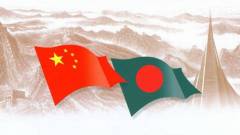China Funded Projects: Red tape holds back progress
With much pomp and circumstances, Xi Jinping in October 2016 arrived in Bangladesh, the first visit by a Chinese president in 30 years.
He left with a promise to provide about $20 billion — the largest amount yet by a single country — over the next four years for Bangladesh’s development, as Beijing looked to one up New Delhi in their contest for geopolitical influence in South Asia.
Three years on, only one-fourth the amount entered the aid pipeline — an anticlimax of sorts.
Some 27 projects are supposed to be funded with the $20 billion as per the initial agreement of October 2016.
Until July, loan agreements — which is the last step before the release of funds — for seven projects involving $5.4 billion were signed and $981.36 million was disbursed.
Red tape on both sides, but particularly in China, is largely to blame for the snail’s pace of loan disbursement, according to finance ministry officials involved in talks with Beijing.
In Bangladesh, the projects must get approval from several committees, which is a long-drawn-out exercise.
“And the situation is even more dragged-out in China,” said a finance ministry official upon condition of anonymity to speak candidly on the matter.
For instance, if the Chinese side do not agree to or fail to understand even a particular word in the project documents, they send the file back to Bangladesh for the process to start afresh.
Besides, China’s Exim Bank has some limitations: only a few officials of the bank deal with foreign loans, so the funds are released very slowly.
The intense lobbying by Chinese firms in both the countries to win the contracts for the development projects cause further delays, the finance ministry official said.
“Having said that, whatever the amount China has released thus far is a big step up when viewed from an historical perspective. They always made negligible donations and their assistance was mostly in the form cheaper contracts.”
Since 2016, $1.8 billion was committed on average each year, which is in line with what the multilateral lenders do.
“Also, as per Chinese Exim bank officials, Beijing does not commit more than $3 billion a year to any country as it deems any amount higher than this might be beyond the repayment capacity of the country,” he added.
Regardless, to probe the slow progress, a joint working group has been formed earlier this year during Prime Minister Sheikh Hasina’s visit to China. The group is likely to meet this month in Dhaka.
At present, five of the China-funded projects are in the implementation stage: the Padma bridge rail link, Karnaphuli river tunnel, phase III of the Info-Sarkar project, installation of a single-point mooring with double pipeline in Maheshkhali and modernisation of telecommunication network for digital connectivity.
The phase-III of the Info-Sarkar project is almost complete, while construction of the Karnaphuli river tunnel project is 48 percent done as of September, said an official of bridges division.
As of August, 17.15 percent of the work for the Padma bridge rail link was done, according to an official of the railways ministry.
During Prime Minister Sheikh Hasina’s tour of China in July this year, loan agreements were signed to expand and strengthen the power supply network under the Dhaka Power Distribution Company involving $1.2 billion.
Another loan agreement involving $280.49 million was struck as part of a $1.12 billion project to strengthen the power grid network under the Power Grid Company of Bangladesh (PGCB).
The remaining loan agreements for the PGCB projects and also for the construction of Dhaka-Ashulia Elevated Expressway involving $1.15 billion will be signed this year, said finance ministry officials.
But it would take some more months to start the implementation work of the projects: a few more official procedures are needed after the signing of loan agreements, they added.
FTA
Apart from financing deals, Beijing proposed a free trade area between the two countries with a view to boost bilateral trade. But the free trade agreement is still at the feasibility study stage.
Commerce ministry officials said two separate studies will be conducted by Bangladesh and China to reach a consensus for the free trade agreement.
In Bangladesh, the tariff commission has been tasked with conducting the preliminary feasibility study and the first draft of the study has been completed.
The aim is to ink a deal before 2024, before Bangladesh graduates from the least-developing country bracket.

